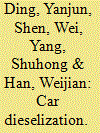| Srl | Item |
| 1 |
ID:
125745


|
|
|
|
|
| Publication |
2013.
|
| Summary/Abstract |
Recently, there is a renewed interest in car dieselization in China to address the challenge of oil security. We developed an econometric model to estimate the vehicle fuels and crude oil demands. The results indicate that if the average travel distance of cars is maintained at the level of 2010-16,000 km/yr, and if the distillation products mix of the refineries remains unchanged, China's crude oil demand in 2020 will reach 1060 million tonnes (Mt), which also results in an excess supply of 107 Mt of diesel. A new balance of diesel supply and demand can be reached and crude oil demand can be significantly reduced to 840 Mt by improving the production ratio between diesel and gasoline on the supply side and promoting passenger vehicle dieselization on the demand side. The crude oil demand will be reduced to 810 Mt in 2020, if the vehicle travel distance gradually drops to 12,000 km/yr. If so, dieselization will provide a rather limited added value-only 6% further oil saving by 2020. Dieselization is not a silver bullet but it depends on a series of key factors: growth rate of gross domestic products (GDP), vehicle sales, and vehicle annual travel distance.
|
|
|
|
|
|
|
|
|
|
|
|
|
|
|
|
| 2 |
ID:
124461


|
|
|
|
|
| Publication |
2013.
|
| Summary/Abstract |
One of the objectives of OPEC is the security of demand for the crude oil exports of its members. Achieving this objective is imperative with the projected decline in OECD countries' crude oil demand among other crude oil demand shocks. This paper focuses on determining the external crude oil demand security risks of OPEC member states. In assessing these risks, this study introduces two indexes. The first index, Risky Energy Exports Demand (REED), indicates the level of energy export demand security risks for OPEC members. It combines measures of export dependence, economic dependence, monopsony risk and transportation risk. The second index, Contribution to OPEC Risk Exposure (CORE), indicates the individual contribution of the OPEC members to OPEC's risk exposure. This study utilises the disaggregated index approach in measuring energy demand security risks for crude oil and natural gas and involves a country level analysis. With the disaggregated approach, the study shows that OPEC's energy export demand security risks differ across countries and energy types.
|
|
|
|
|
|
|
|
|
|
|
|
|
|
|
|